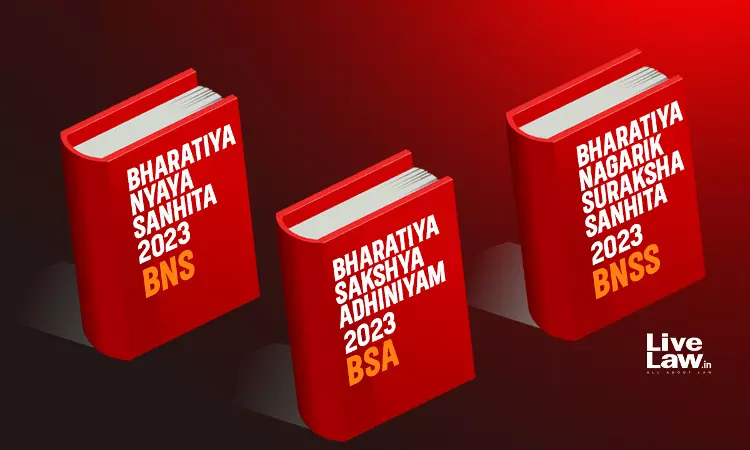A Modern Indian Legal System, But One That Needs More Fine-Tuning
Akshat Khetan
27 July 2024 12:04 PM IST

As the world moved to the seventh month of 2024, India awakened to a transformative era. An era which promises to overhaul a set of colonial rules that have impeded its criminal justice system for a long time. The reforms, introduced with the objective of addressing longstanding inadequacies and inefficiencies in the legal framework, mark a significant departure from previous statutes that have governed India for decades. The revamped legal structure aims to streamline judicial processes, enhance the efficacy of law enforcement, and uphold the principles of justice and fairness.
One of the cornerstone changes is the replacement of the Indian Penal Code (IPC), the Criminal Procedure Code (CrPC), and the Indian Evidence Act, with newly formulated laws: the Bharatiya Nyaya Sanhita (BNS), the Bharatiya Nagarik Suraksha Sanhita (BNSS), and the Bharatiya Sakshya Adhiniyam (BSA). These new statutes seek to modernize the criminal justice system by incorporating technological advancements, ensuring quicker dispensation of justice, and aligning with contemporary societal values.
WHAT HAS CHANGED?
To begin with, the BNS introduces pivotal amendments to substantive criminal law. Notable among these is the decriminalization of several minor offenses, which aims to reduce the burden on the judiciary and prioritize severe crimes. The reclassification of offenses into cognizable and non-cognizable categories has been refined to ensure more efficient handling by law enforcement agencies. For instance, cybercrimes have been given a distinct focus with stringent penalties, reflecting the growing menace of digital offenses. Moreover, the law mandates stricter punishments for crimes against women and children, signaling a robust stance against gender-based violence and child exploitation.
A major overhaul is also the implementation of the BNSS, which governs the procedural aspects of criminal law, which are anticipated to expedite legal process. Key reforms include the digitization of First Information Reports (FIRs) and case management systems, which are expected to reduce procedural delays significantly. The law introduces provisions for summary trials for minor offenses, thereby unclogging the overburdened courts. Furthermore, the BNSS emphasizes the protection of victims' rights, mandating timely compensation and support mechanisms, which is a significant shift towards a more victim-centric approach.
The BSA addresses the rules of evidence, aiming to enhance the integrity and reliability of evidence presented in courts. One of the notable introductions is the acceptance of digital evidence, including electronic records, as admissible in court, provided they meet certain authenticity criteria. This is a crucial development given the increasing reliance on digital transactions and communications. Additionally, the BSA emphasizes the protection of witness identities in sensitive cases, a measure designed to encourage witness cooperation and safeguard them from intimidation or retribution.
In simple words, the legal wrangle is expected to be resolved with faster turn-around times. Adoption of technology is also evident with the notable inclusion of compulsory audio-video recording during a search and seizure. Clearly, timeline has been added in 35 sections wherein charges are to be framed within 60 days of first hearing. In criminal cases, judgements have to be delivered within 45 days of conclusion of trial.
GOOD, BAD, & SCOPE FOR IMPROVEMENT
The implementation of these laws necessitates extensive training and capacity-building for law enforcement officers, judicial staff, and legal practitioners. The government has initiated training programs to familiarize stakeholders with the new legal provisions and procedural requirements. Moreover, the integration of technology in law enforcement and judicial processes calls for significant investments in digital infrastructure and cybersecurity measures.
Implementation of the legal structure has given rise to hope although it needs fine-tuning and passionate public discussion. Interpretation in some sections has given rise to anxiety and fear. For instance, in section 106, usage of the word 'negligence' has spooked fear among practicing doctors. Similarly, exclusion of men and animals as victims of rape; or the wordage in Section 69 which considers the inability to fulfill marriage, having a sexual intercourse as liable with imprisonment of ten years and/or a fine; these are examples where additional scrutiny is required.
Despite the progressive intent of these reforms, their success hinges on effective implementation. Challenges such as bureaucratic inertia, resource constraints, and resistance to change may impede the smooth transition to the new legal framework. Continuous monitoring, feedback mechanisms, and adaptive policy adjustments will be crucial in overcoming these hurdles. Additionally, public awareness campaigns are essential to educate citizens about their rights and responsibilities under the new laws.
Author: Akshat Khetan is a distinguished corporate and legal advisor. Views are personal.

